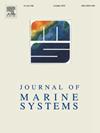黄河口及邻近水域悬沙浓度的季节和空间变化及其机制
IF 2.5
3区 地球科学
Q2 GEOSCIENCES, MULTIDISCIPLINARY
引用次数: 0
摘要
悬沙浓度(SSC)在沿海环境的生态和地貌动力学中起着至关重要的作用,特别是在泥沙通量较大的河口。本研究以黄河河口及其邻近海域为研究对象,该海域是世界上SSC最高的沿海地区之一。虽然对该地区南盐含量的季节和空间变化及其机制已经有了一定的了解,但在了解南盐含量高分布的空间差异及其动力机制方面仍然存在空白。为了弥补这些空白,利用4个研究巡航的观测和基于区域海洋模拟系统(ROMS)的数值模式模拟来研究SSC的变率及其机制。研究结果表明,YR口和邻近水域的SSC具有显著的季节变化,冬季由于风引起的再悬浮更强,SSC浓度更高。确定了两个关键热点:YR口和渤海海峡南部。高SSC是由河流输入的水平输送和YR河口底部沉积物的再悬浮引起的,主要是由渤海海峡南部的底部再悬浮引起的。此外,潮汐速度被认为是整个潮汐周期中SSC变化的主要驱动因素,观测时间的潮汐阶段显著影响观测到的SSC,并在基于巡航观测的空间分布分析中引入不确定性。在沉积物再悬浮过程中,海流和波浪引起的底部切应力(BSSs)都起主要作用,而波浪引起的底部切应力(BSSs)在SSC的季节变化中起主导作用。研究结果将有助于进一步认识河口及其邻近水域的泥沙动力学。本文章由计算机程序翻译,如有差异,请以英文原文为准。

Seasonal and spatial variability and mechanisms of suspended sediment concentration in the Yellow River mouth and adjacent waters
Suspended sediment concentration (SSC) plays a critical role in the ecological and geomorphological dynamics of coastal environments, particularly in river mouths where sediment fluxes are substantial. This study focuses on the Yellow River (YR) mouth and its adjacent waters, which is one of the coastal areas with the highest SSC in the world. Although some efforts have been made to understand the seasonal and spatial variability and mechanisms of SSC in this region, gaps remain, particularly in understanding the spatial disparity in high SSC distributions and its dynamic mechanisms. To address these gaps, observations based on four research cruises and numerical model simulations based on the Regional Oceanic Modeling System (ROMS) are conducted to study the variability and mechanisms of SSC. The findings reveal that SSC in the YR mouth and adjacent waters exhibits significant seasonal variability, with higher concentrations during winter due to stronger wind-induced resuspension. Two key hot-spots are identified: the YR mouth and the southern Bohai Strait. The high SSC is attributed to horizontal transport of riverine input and resuspension of bottom sediments in the YR mouth, and is mainly induced by bottom resuspension in the southern Bohai Strait. Additionally, tidal velocity is identified as a primary driver of SSC variations throughout the tidal cycle, with tidal phases of the observation time significantly influencing observed SSC and introducing uncertainty in spatial distribution analyses based on cruise observations. The current- and wave- induced bottom shear stresses (BSSs) both play primary roles in sediment resuspension, while the wave-induced BSS dominates the seasonal variability of SSC. The results are expected to contribute to advancing the understanding of sediment dynamics in river mouth and its adjacent waters.
求助全文
通过发布文献求助,成功后即可免费获取论文全文。
去求助
来源期刊

Journal of Marine Systems
地学-地球科学综合
CiteScore
6.20
自引率
3.60%
发文量
81
审稿时长
6 months
期刊介绍:
The Journal of Marine Systems provides a medium for interdisciplinary exchange between physical, chemical and biological oceanographers and marine geologists. The journal welcomes original research papers and review articles. Preference will be given to interdisciplinary approaches to marine systems.
 求助内容:
求助内容: 应助结果提醒方式:
应助结果提醒方式:


